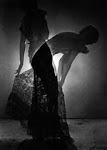Dreams in Celluloid, Part III
80. JULES DASSIN
‘Out of the worst crime novels I ever read, Jules Dassin has made the best crime film I've ever seen.’ François Truffaut. Blacklisted by Hollywood in the 1950s, Dassin went to France where he made one of the greatest Film Noir style crime films ever. This is the film that includes the now infamous twenty-three minute silent robbery scene. A big influence on later French crime films, especially Melville, not to mention the countless Hollywood crime capers.
79. JOSEF VON STERNBERG
Visually this film is stunning with all the hallmarks of Sternberg's lush, expressionistic style, but what gives it the edge of works like The Blue Angel and Shanghai Express is how far Sternberg was willing to push these elements. Dietrich certainly wasn’t the best actress of her time, but what she did bring to a film was incredible presence. She sure did have charisma. And Sternberg was the director who could make the most of that. Dietrich was so comfortable in Sternberg’s presence that she barely had to do anything and he was able to capture exactly what he was after. The dialogue may be a little awkward, but as a visual spectacle it's something else.
78. KEN LOACH
Ah, to be a kid growing up in the sixties in working class Barnsley, Northen England. While Godard and Truffaut were making light-hearted New Wave cinema in Paris, Ken Loach was making dark, grim and gritty social realist films in Northern England, where even the briefest of hopes seems out of reach.
77. ZHANG KE JIA
I can’t say I’ve seen that many Chinese films and Still Life certainly has a European film to it, mostly because of its slow Antonioni style pacing, but despite that this film is still very much about China and the specifically the effect of the Three Gorges project, which continues to split the country, divide communities and isolate families. And Still Life captures that specifically Eastern style of searching for something from the past as a coalminer travels to Shanxi to look for his ex-wife he hasn’t seen in 16 years and a nurse Fengjie to look for a husband who hasn’t returned home for 2 years. Still Life is highly evocative of the human cost China’s global emergence has led to.
76. JACQUES BECKER
In the 1930s, Becker worked as Renoir’s assistant on some of his most memorable films, but during the 40s and 50s, Becker became an interesting director in his own right. So there are a few perhaps inevitable similarities between Becker and Renoir, but the former had a much more direct approach to cinema. Above all else, Becker was an observer. There’s a lot to enjoy about any of his three most accomplished films (Casque d’Or, Touchez Pas Au Grisbi, and Le Trou), the dappled impressionistic light, his poetic touches, the lightness of his style. So Casque d’Or has a particularly simple love plot, about a former crook trying to go straight, but there’s a lot of charm, which reminds me in particular of Jean Vigo at his best.
75. PATRICE LECONTE
Fed up with your own life, then why not become someone else. Easier said than done, right? Well, that’s the idea that Leconte explores in [i]L’Homme du Train[/i], though I could probably have picked any number of Leconte’s films and they’d explore similar issues – mistaken identity, strange relationships, characters longing to be someone else – but L’Homme du Train is perhaps his greatest realisation of these ideas. There is something inherently French about his films that I don’t think any other country is capable of producing, and while the pacing is slow and subtle, the depth of character and plot are incredibly strong.
74. SAM PECKENPAH
If ever you want to build and maintain tension in a film then watch Straw Dogs. Few other films are capable of such punishing conflict. And even if Dustin Hoffman was only doing it for the money, his portrayal of David Summer as the quiet, geeky professor is perfect. And there’s a good reason for Peckenpah’s association with violence on screen – just watching the opening sequence of the The Wild Bunch is exhilarating.
73. D.W. GRIFFITH
There’s something very beautiful about watching a film by D. W. Griffith. I think it’s partly because of the very timeless quality of his films and the sense that they cannot be recreated in the same way other silent era films can be pastiched or reworked in the present. Orphans of the Storm has a typically strong plot, exquisite staging, and some of the best acting I’ve seen in a silent film by the Gish sisters. Of course it’s still a stylised melodrama, but it’s one of the best.72. GUY MADDIN
And talking of silent film pastiche, are there any other contemporary directors able to do it with such understanding and originality as Guy Maddin? The key to avoiding plagiarism is innovation and Maddin is certainly an innovator. Taking silent films as a foundation, he uses their highly distinctive brand of filmmaking to explore his own bizarre, psychosexual, surrealist narratives and situations. Love triangles, mistaken genders, incest, it’s all in there. 71. MAYSLES BROTHERS
The film that's been remade all over the place, but no remake is going to equal the weirdness of the original documentary. And how do people become so crazy? Publicity, money, power? It’s a very sad film in a way, but the Maysles Brothers manage to keep just the right balance between sympathy and absurdity. Judge for yourself.













0 comments:
Post a Comment